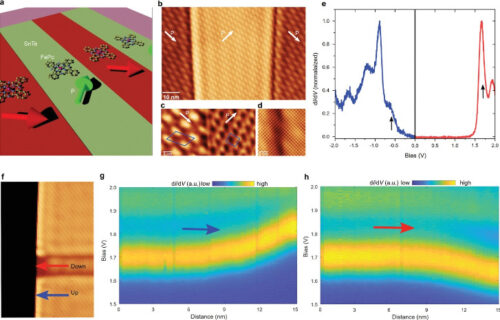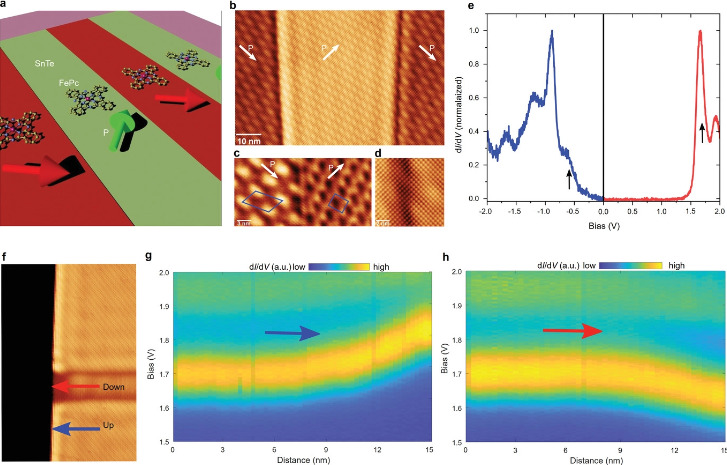研究者らは、電気的に制御可能な基板を用いて、個々の分子の量子状態を制御する方法を示しました。 Researchers demonstrated how to control the quantum states of individual molecules with an electrically controllable substrate.
2023-01-09 フィンランド・アールト大学
単一分子の電子配置を制御することができれば、基礎科学と技術の両面で大きな進展が期待できる。一方では、分子の内部状態を制御することで、エキゾチックな性質をもつ新しい人工材料を開発することができるかもしれない。一方、古典的なコンピュータのメモリを究極的に小型化することも可能になるかもしれない。2つの配置を利用すれば、古典的なメモリユニットに0と1を分子レベルで符号化することが可能になるかもしれないのだ。しかし、分子の内部状態を制御することはまだ困難であり、それを克服するための現実的でスケーラブルな戦略は提案されていない。
アールト大学とユヴァスキュラ大学の研究者らは、電気的に制御可能な基板を用いて個々の分子の量子状態を制御できることを、最近の実験的なブレークスルーとして実証した。この実験により、SnTeと呼ばれる特定の二次元材料が、分子状態を制御するために必要な装置戦略を提供することが示されました。
研究者らが示したメカニズムは、基板が内部電場によって分子の内部状態を調整する能力に基づいている。このメカニズムは強誘電体分子スイッチングとして知られ、研究者は基板に電圧をかけるだけで個々の分子を制御することができるようになる。この方法は、強誘電性として知られるユニークな量子特性に由来する、外部電圧によるSnTeの強力な調整能力に依存している。
今回の実験では、2次元強誘電体によって、電気的に切り替え可能な量子状態を実現できることを実証しました。量子状態を電気的に制御することは、量子材料における大きなマイルストーンであり、今回、それを個々の分子の最も深いレベルで行うための戦略の1つを実証しました」と、この研究の筆頭著者である博士研究員のMohammad Aminiは語っている。
基板効果による分子の量子制御は、量子物質の新しい可能性を開くものであり、状態を切り替えられる人工分子材料の工学的応用も可能です」。この研究は、『Advanced Materials』誌に最近掲載された。
<関連情報>
- https://www.aalto.fi/en/news/controlling-quantum-states-in-individual-molecules-with-two-dimensional-ferroelectrics
- https://onlinelibrary.wiley.com/doi/10.1002/adma.202206456
van der Waals単層強誘電体を用いた分子軌道整列の制御 Control of Molecular Orbital Ordering Using a van der Waals Monolayer Ferroelectric
Mohammad Amini, Orlando J. Silveira, Viliam Vaňo, Jose L. Lado, Adam S. Foster, Peter Liljeroth, Shawulienu Kezilebieke
Advanced Materials Published: 16 December 2022
DOI:https://doi.org/10.1002/adma.202206456

Abstract
2D ferroelectric materials provide a promising platform for the electrical control of quantum states. In particular, due to their 2D nature, they are suitable for influencing the quantum states of deposited molecules via the proximity effect. Here, electrically controllable molecular states in phthalocyanine molecules adsorbed on monolayer ferroelectric material SnTe are reported. The strain and ferroelectric order in SnTe are found to create a transition between two distinct orbital orders in the adsorbed phthalocyanine molecules. By controlling the polarization of the ferroelectric domain using scanning tunneling microscopy (STM), it is successfully demonstrated that orbital order can be manipulated electrically. The results show how ferroelastic coupling in 2D systems allows for control of molecular states, providing a starting point for ferroelectrically switchable molecular orbital ordering and ultimately, electrical control of molecular magnetism.




